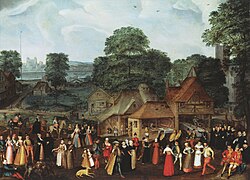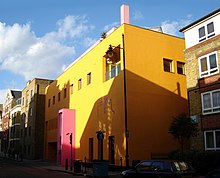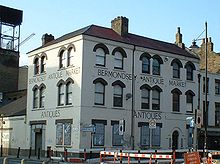Bermondsey: Difference between revisions
No edit summary |
|||
| Line 23: | Line 23: | ||
The first 'Bermondsey' is that known from later charters to be the area around the ancient Abbey and its manor, which was in turn part of the early mediaeval parish. References in the Rolls describe it as "in Southwark". A later, Victorian, civil parish of 'Bermondsey' did not include Rotherhithe or St Olave's; this was the arrangement under the Metropolis Management Act of 1855. The Southwark parishes of St Olave's and St John's Horsleydown (the latter a 'daughter' of the former) with St Thomas's formed a parish 'union' (' District Board of Works ') known as 'St Olave's' from that date. These were the arrangements within the London County from 1889 . In 1899 St Olave and St Thomas's District was merged as one 'Civil Parish' and the next year, following London government reorganisation, these also were merged with Rotherhithe and part of Deptford to form, with the 'Bermondsey' civil parish, the 'Metropolitan Borough of Bermondsey'. This borough disappeared in the Greater London reorganisation into the London Borough of Southwark in 1964. |
The first 'Bermondsey' is that known from later charters to be the area around the ancient Abbey and its manor, which was in turn part of the early mediaeval parish. References in the Rolls describe it as "in Southwark". A later, Victorian, civil parish of 'Bermondsey' did not include Rotherhithe or St Olave's; this was the arrangement under the Metropolis Management Act of 1855. The Southwark parishes of St Olave's and St John's Horsleydown (the latter a 'daughter' of the former) with St Thomas's formed a parish 'union' (' District Board of Works ') known as 'St Olave's' from that date. These were the arrangements within the London County from 1889 . In 1899 St Olave and St Thomas's District was merged as one 'Civil Parish' and the next year, following London government reorganisation, these also were merged with Rotherhithe and part of Deptford to form, with the 'Bermondsey' civil parish, the 'Metropolitan Borough of Bermondsey'. This borough disappeared in the Greater London reorganisation into the London Borough of Southwark in 1964. |
||
Parts of Southwark (between London Bridge and Tower Bridge, most notably Hays Galleria), Tooley Street and Camberwell (Old Kent Road) are often mistakenly assigned to 'Bermondsey'. The present council has divided the borough into 'Community Council' areas and has promoted signage for identity. These are based, for convenience, on the current wards and therefore 'Borough and Bankside' (old Southwark) intrudes into Bermondsey Street, the oldest part of ' Bermondsey '. The Community Council named 'Bermondsey' comprises the wards of 'Riverside' (effectively Rotherhithe) and 'South Bermondsey' (areas south of Lower Road). |
Parts of Southwark (between London Bridge and Tower Bridge, most notably Hays Galleria), Tooley Street and Camberwell (Old Kent Road) are often mistakenly assigned to 'Bermondsey'. The present council has divided the borough into 'Community Council' areas and has promoted signage for identity. These are based, for convenience, on the current wards and therefore 'Borough and Bankside' (old Southwark) intrudes into Bermondsey Street, the oldest part of ' Bermondsey '. The Community Council named 'Bermondsey' comprises the wards of 'Riverside' (effectively Rotherhithe), 'Grange' and 'South Bermondsey' (areas south of Lower Road). |
||
== Parliamentary Representation == |
== Parliamentary Representation == |
||
Revision as of 01:46, 24 April 2008
Bermondsey (Template:PronEng) is an area in modern London on the southern bank of the river Thames presently part of the London Borough of Southwark. To its west lies Southwark to its east Rotherhithe. 'Bermondsey' cannot be defined as a place without some reference to a period.
Parish, Vestry and Local Government
The first 'Bermondsey' is that known from later charters to be the area around the ancient Abbey and its manor, which was in turn part of the early mediaeval parish. References in the Rolls describe it as "in Southwark". A later, Victorian, civil parish of 'Bermondsey' did not include Rotherhithe or St Olave's; this was the arrangement under the Metropolis Management Act of 1855. The Southwark parishes of St Olave's and St John's Horsleydown (the latter a 'daughter' of the former) with St Thomas's formed a parish 'union' (' District Board of Works ') known as 'St Olave's' from that date. These were the arrangements within the London County from 1889 . In 1899 St Olave and St Thomas's District was merged as one 'Civil Parish' and the next year, following London government reorganisation, these also were merged with Rotherhithe and part of Deptford to form, with the 'Bermondsey' civil parish, the 'Metropolitan Borough of Bermondsey'. This borough disappeared in the Greater London reorganisation into the London Borough of Southwark in 1964.
Parts of Southwark (between London Bridge and Tower Bridge, most notably Hays Galleria), Tooley Street and Camberwell (Old Kent Road) are often mistakenly assigned to 'Bermondsey'. The present council has divided the borough into 'Community Council' areas and has promoted signage for identity. These are based, for convenience, on the current wards and therefore 'Borough and Bankside' (old Southwark) intrudes into Bermondsey Street, the oldest part of ' Bermondsey '. The Community Council named 'Bermondsey' comprises the wards of 'Riverside' (effectively Rotherhithe), 'Grange' and 'South Bermondsey' (areas south of Lower Road).
Parliamentary Representation
Bermondsey's Parliamentary representation has increased and declined with its population. After the 1832 Reform Act it became part of the 'Southwark' constituency, which is why the main public park is called 'Southwark Park'. During the twentieth century it had a distinct representaion and was the so called 'Bermondsey' seat which included part of the older Southwark area, until 2003 when boundary changes merged it with that area and this was reflected in name change to North Southwark and Bermondsey.
History
Saxon and Norman period
The area was originally named "Beormund's Ey", Beormund being a Saxon personal name, "ey" being a contraction of 'eyot' in old English for "island". At this time it would have been little more than a marshy riverside island.
Bermondsey appears in Domesday Book as Bermundesy(e). It was held by King William. Its Domesday Assets were: 12 hides; 'A new and handsome' church, 5 ploughs, 20 acres of meadow, woodland worth 5 hogs. It rendered (in total): £15.[1]
The church may have been the original gift of one Aylwin 'Cild' an Englishman who also gave properties in London to support the St Charite house at Cluny. It was the Cluniac monks who then established a Priory, later Bermondsey Abbey dedicated to 'St Saviour', on the site in 1082 and began the development of the area, cultivating the land and embanking the riverside. They turned an adjacent tidal inlet at the mouth of the River Neckinger into a dock, named St Saviour's Dock after the abbey. ' Bermondsey ' then was little more than a high street ribbon (Bermondsey Street)leading from the southern bank of the Thames, at Tooley Street, up to the Abbey close.


The Knights Templar also owned land here and gave their names to one of the most distinctive streets in London, Shad Thames (a corruption of "St John at Thames"). Other ecclesiastical properties stood nearby at Tooley (a corruption of "St Olave's") Street, where wealthy citizens and clerics had their houses, including the Priors of Lewes, the Abbots of Battle and the Priors of St Augustine, Canterbury, although this was part of the Southwark manor of Canterbury.
14th century
King Edward III built a manor house close to the Thames in Bermondsey in 1353. The excavated foundation are visible next to Bermondsey Wall East close to the Famous Angel public house.[2]
17th century
As it developed over the centuries, Bermondsey underwent some striking changes. After the Great Fire of London, it was settled by the well-to-do and took on the character of a garden suburb especially along the lines of Grange Road, as Bermondsey Street became more urbanised, and of Jamaica/ Lower Road. A pleasure garden was founded there in the 17th century, commemorated by the Cherry Garden Pier. Samuel Pepys visited "Jamaica House" at Cherry Gardens in 1664 and recorded in his diary that he had left it "singing finely".
Though not many buildings survive from this era, one notable exception is the church of St Mary Magdalen on Bermondsey Street, completed in 1690 (although a church has been recorded on this site from the 13th Century). This church came through both 19th-century redevelopment and The Blitz unscathed. It is not just an unusual survivor for Bermondsey; buildings of this era are relative rarities in Inner London in general.
18th century
In the 18th century, the discovery of a spring in the area led to Bermondsey becoming a spa leisure resort, as the area between Grange and Jamaica Roads called Spa Road commemorates.
19th century
It was from the Bermondsey riverside that the painter J.M.W. Turner executed his famous painting of The Fighting "Temeraire" Tugged to her Last Berth to be Broken Up (1839), depicting the veteran warship being towed to Rotherhithe to be scrapped.
By the mid-19th century parts of Bermondsey, especially along the riverside had become a notorious slum - with the arrival of industrial plants, docks and immigrant housing. The area around St Saviour's Dock, known as Jacob's Island, was one of the worst in London. It was immortalised by Charles Dickens's novel Oliver Twist, in which the principal villain Bill Sikes meets a nasty end in the mud of 'Folly Ditch' - the scene of an attack by Spring Heeled Jack in 1845 - surrounding Jacob's Island. Dickens provides a vivid description of what it was like:
- "... crazy wooden galleries common to the backs of half a dozen houses, with holes from which to look upon the slime beneath; windows, broken and patched, with poles thrust out, on which to dry the linen that is never there; rooms so small, so filthy, so confined, that the air would seem to be too tainted even for the dirt and squalor which they shelter; wooden chambers thrusting themselves out above the mud and threatening to fall into it - as some have done; dirt-besmeared walls and decaying foundations, every repulsive lineament of poverty, every loathsome indication of filth, rot, and garbage: all these ornament the banks of Jacob's Island."
Bermondsey Town Hall was built on Spa Road in 1881.

The area was extensively redeveloped during the 19th century and early 20th century with the expansion of the river trade and the arrival of the railways. London's first passenger railway terminus was built by the London to Greenwich Railway in 1836 at London Bridge, connecting Bermondsey with Greenwich. The line ran for four miles on 878 brick arches, with the linked Croydon Railway opening in 1839.This was an extension,to the London to Greenwich railway, the first section to be used was between the Spa Road Station (http://en.wikipedia.org/wiki/Spa_Road_station) and Deptford High Street. This local station had closed by 1915.
The industrial boom of the 19th century was an extension of Bermondsey's manufacturing role in earlier eras. As in the East End, industries that were deemed too noisome to be carried on within the narrow confines of the City of London had been located here - one such that came to dominate central Bermondsey, away from the riverfront, was the processing and trading of leather and hides. Many buildings from this era survive around Leathermarket Street including the huge Leather, Hide and Wool Exchange (now residential and small work spaces). Hepburn and Gale's tannery (disused as of early 2007) on Long Lane is also a substantial survivor of the leather trade.
20th century

From 1899 to 1965, Bermondsey formed part of the Metropolitan Borough of Bermondsey.
To the east of Tower Bridge, Bermondsey's 3½ miles of riverside were lined with warehouses and wharves, of which the best known is Butler's Wharf. They suffered severe damage in World War II bombing and became redundant in the 1960s following the collapse of the river trade. After standing derelict for some years, many of the wharves were redeveloped under the aegis of the London Docklands Development Corporation during the 1980s. They have now been converted into a mixture of residential and commercial accommodations and have become some of the most upmarket and expensive properties in London. In 1997, US President Bill Clinton and Prime Minister Tony Blair visited the area to dine at the Pont de la Tour restaurant at Butler's Wharf.
Despite the presence of London Bridge station, Bermondsey's transport links with the rest of London have historically been poor. This was remedied in 1999 with the opening of Bermondsey tube station on the London Underground's Jubilee Line Extension.


Places of interest
- Bermondsey antiques market
- Tower Bridge
- HMS Belfast
- London Dungeon
- Fashion and Textile Museum
- Shad Thames
- Mandela Way T-34 Tank
- Millwall F.C.
- Miloco Studios
- Bermondsey Spa Gardens
Nearest places
Nearest stations
See also
- Antenna Audio, UK office
- Jade Goody who came fourth in the reality TV show Big Brother in 2002 grew up in Bermondsey and attended Bacons College secondary school in Rotherhithe.
- Paul O'Grady a.k.a Lily Savage who is a comedian and all round TV presenter lives in Bermondsey near Tower Bridge.
- Arthur Smith- comedian
- Millwall F.C.
- Madeline Duggan, is an English Actress best known for playing Lauren Branning in the BBC1 soap opera EastEnders
- Paterson Park in Bermondsey is named after a noted prison reformer, Sir Alexander Paterson.[3]
References
- ^ Surrey Doomsday Book
- ^ Staff. The London Borough of Southwark [[English Heritage]. (cached) "This page provides an overview of the Borough’s fascinating archaeology..."
- ^ London SE1 community website


